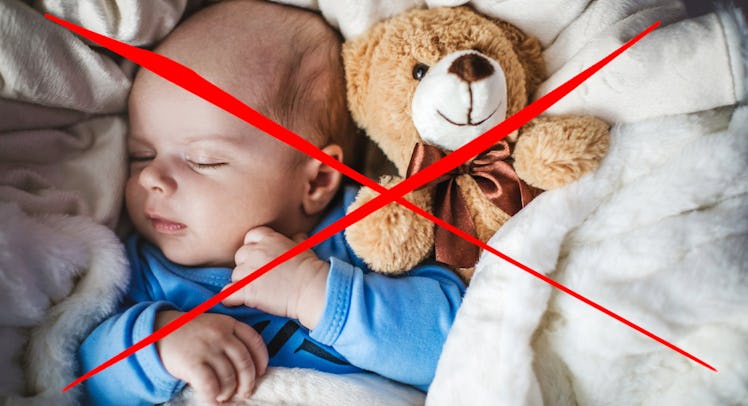The Dangerous Baby Sleep Photo That Appear All Over Instagram
"You show people pictures of safe sleep and they think that looks lonely. That’s part of the challenge, the public perception fueled by the images we see.”

Instagram and Pinterest thrive on aspiration. The most shared and liked posts are those that show a world in which their users want to live, filled with stunning vistas, attractive people, delicious food and carefully curated living spaces. But the world adult users of social media want to love and share can be deeply at odds with the world that is optimal for child development and safest for children. And when social media platforms like Instagram and Pinterest inspire parents to make unsafe choices in products and decor, the image platforms can be downright dangerous for infants and kids.
Nowhere is this truer than in the case of infant nurseries. When an expectant parent browses Pinterest for nursery ideas, they find image after image of cozy spaces featuring cribs draped with luxurious, soft, throw-blankets and staged with cute stuffed animals. Instagram is full of these photos, too. The message in the images is that babies require the soft and comfortable and that stuffed animals in the crib are cute and harmless. To not provide these things would make a space that feels unfriendly and wrong.
But make no mistake: the feel of a nursery is not for a baby, it’s for a parent. Having mobiles, murals, or trendy color schemes do not help or enhance a child’s development. And, in fact, when stuffed animals and blankets are added to cribs, babies can die. The presence of blankets, stuffed animals, and pillows in cribs has been shown to increase the risk of SIDS deaths from suffocation, strangulation, or entrapment.
The best sleeping environment for children is decidedly austere. That doesn’t sit right with a lot of parents, according to Dr. Ben Hoffman, chair of the American Academy of Pediatrics Council on Injury, Violence, and Poison Prevention. “The safest baby who’s sleeping looks, to many parents, wrong on the surface,” Hoffman says. “The right image is a baby on a flat firm mattress on their back with nothing else. You show people pictures of safe sleep and they think that looks lonely. That’s part of the challenge, the public perception fueled by the images we see.”
Hoffman notes that the best bedding is a firm mattress with a single fitted sheet that will not become detached. That’s it. Nothing pillowy and soft. Nothing friendly or cuddly. But that’s not the image parents want to share. That’s because a picture of a boring safe sleep area does not and cannot signal status, or taste, or creativity.
The problem is not a theoretical one. Hoffman helped drive the AAP push for the recall of the Fisher-Price Rock ‘n Play earlier this year. He notes that the Rock ‘n Play’s was popular in part because it was so Instagrammable.
“What we pick is driven by the images we see,” Hoffman says. He notes that the safe alternative to the Rock’ n Play, the ubiquitous pack and play, simply doesn’t have the same kind of pretty appeal. “What are you going to pick? Something with cute animals? It’s especially driven by social media and mommy shaming. You look at a picture of a pack and play and what do you think? Boring.”
But for babies, when it comes to sleep, boring is an exceptionally good thing. Babies should always be placed on their back, maybe swaddled, on a sheet covered firm mattress in a crib. The room should be free of devices and lights, save for a fan, which offers white noise and has been shown to decrease the risks of SIDS.
What Pinterest and Instagram have essentially done is shifted parental perceptions of risk around sleep. And not just in terms of nursery furniture and accessories but also behaviors. Consider the common photograph of a father sleeping on the couch with a baby on his chest. On the surface the image would seem endearing, illustrating a caring father bonding with his baby. But in reality, the photos represent a situation which can sometimes lead to tragic entrapment death if the father shifts and the baby gets caught between his body and the cushions.
Parents need to remember that safety isn’t Instagramable. It can’t be Pinned. And as natural as it seems, sleep in the modern world can be a risky proposition.
“There’s a huge problem in the perception of risk,” Hoffman explains. “Adults don’t perceive sleep as risky. But 10 babies die a day in their sleep in the United States. There is a risk and you need to know how to minimize risk.”
This article was originally published on